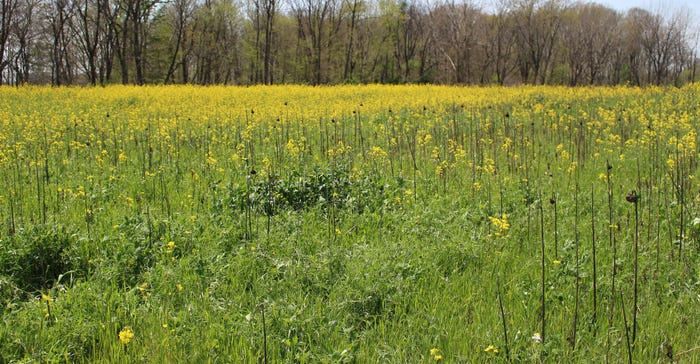May 27, 2021

As I drove around the Indiana countryside during late April, I noticed a familiar sight: worked and planted fields. These tilled, bare fields often lead to horrible erosion and lost profitability as early spring rains impact the soil surface. This leads to a net loss in soil, organic matter, fertilizer and other chemicals.
As I rounded a curve, I came across the farm of Roger Wenning, Greensburg. His fields weren’t bare or worked, yet his spring fieldwork was getting done. How? Wenning uses cover crops to keep his fields covered and protected.
He plants directly into this mass of living plant roots and manages accordingly to achieve a system where the soil doesn’t crust after a rain, water can easily infiltrate, and oxygen can freely flow into the soil for roots and microbes. Essential nutrients not only remain there after being applied, but Wenning has found that cover crops provide some essential nutrients, too.
Legume cover crops such as field peas, crimson clover and hairy vetch fix nitrogen from the atmosphere. The air we breathe is 78% nitrogen. Fixation is the process by which this atmospheric nitrogen is converted to plant-available form, namely amino acids.
Legumes do this with the help of specialized rhizobium bacteria that form a symbiotic relationship with the legume. The plant creates a nodule on its root where the bacteria live and thrive and do their work for the plant. The plant feeds the rhizobium bacteria carbon created through photosynthesis. Wenning terminates his cover crops at an optimal time, right at planting, so legumes can release fixed nitrogen to newly planted corn.
Nitrogen boost
Wenning will tell you he hasn’t changed the amount of nitrogen he applies. He’s maybe changed the timing and the source, but the rate has remained essentially unchanged over the past 20 to 25 years. Wenning says yields have gone up and nitrogen use efficiency has improved. He once used the standard calculation of 1.2 units of nitrogen for every bushel of corn. Now, he is down to 0.8 unit of N for every bushel of corn. His legumes are providing more N, especially early.
How is this possible? The soils he farms are nothing like the deep, rich prairie soils of Illinois or the flat, dark soils of northern Indiana. Yet he sees yield and profitability increases that he attributes to the health of his soil.
We dug some holes at Wenning’s farm that April afternoon to look at his nutrient source makers: field pea and hairy vetch roots. What I saw amazed me — prolific legume nodules, all actively fixing nitrogen. How could I tell? By color — nodules actively fixing nitrogen will have a pinkish or reddish color inside.
Wenning built a living system in his field: an ecosystem that prospers with the essentials of water, sunshine and living roots to provide nutrients for other plants to thrive.
This isn’t something that happened overnight. It took lots of intentional planning. There is no “easy button” when it comes to rebuilding a soil’s health. I say “rebuilding” because whether we want to admit it or not, most agricultural soils are degraded in some way.
For farmers like Wenning, realizing this is the key to starting fresh and investing time, energy and money into building a system that can regenerate and repair itself. Talk about a living system!
McLain is the state soil health specialist with the Natural Resources Conservation Service in Indiana.
Read more about:
No tillYou May Also Like




